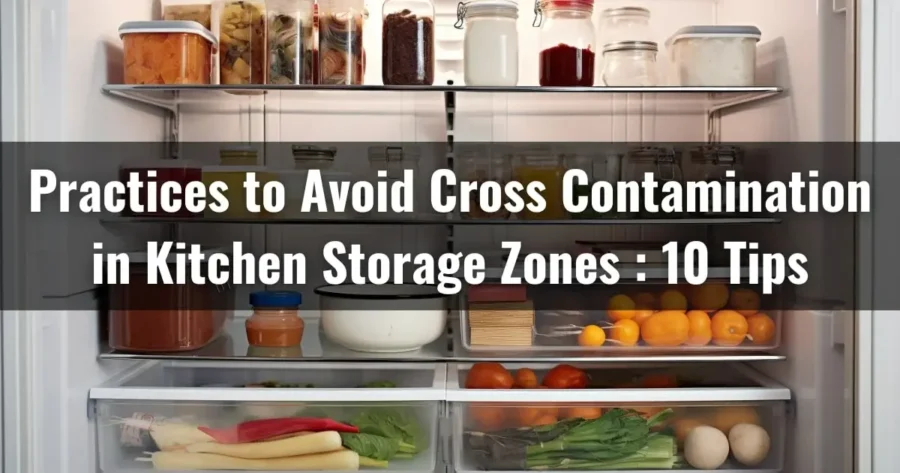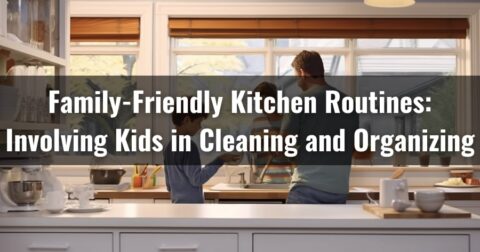A clean, hygienic kitchen environment is essential for ensuring the safety and quality of our food. But did you know that cross-contamination can easily occur in your storage zones? Therefore, you must maintain hygienic practices to prevent harmful bacteria from spreading in your kitchen storage.
You must maintain designated storage areas for different types of food to prevent mixing and contamination. Using effective containers that are properly sealed and labeled can further minimize the risk of cross-contamination.
Maintaining a temperature-controlled environment for cold and dry storage and ensuring proper refrigeration can help keep your stored food safe.
Here, we’ll discuss simple yet effective hygienic practices and tips to prevent cross-contamination in your kitchen storage areas. From proper labeling and organizing to regular cleaning and sanitizing, you’ll understand how to keep your food safe for consumption.
Jump to Section
10 Hygienic Practices to Avoid Cross Contamination in Kitchen Storage Zones
Keeping your kitchen storage areas clean and organized is essential for preventing cross-contamination.
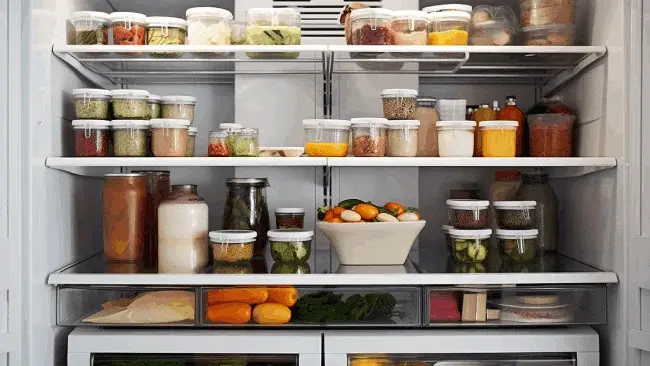
Here are ten hygienic practices to consider:
No 01: Maintaining Designated Storage Areas
Establishing and following a clear system is key to organizing designated storage areas in your kitchen. Start by assigning specific areas for different kinds of food, such as raw meats, fruits, vegetables, and ready-to-eat items.
Make sure to separate high-risk foods, like raw meats and dairy, from ready-to-eat items to minimize the risk of cross-contamination. Clearly label each storage area to avoid any confusion.
No 02: Effective Use of Containers
Effective use of containers is another essential practice for preventing cross-contamination in kitchen storage zones. To store food, use clean and undamaged containers with tight-fitting lids, foil, or plastic film.
When removing items from their original packaging, transfer them to sanitized containers and label them with the name and original use-by or expiration date. This practice reduces the risk of contamination by ensuring that food is stored hygienically and organized.
No 03: Controlled Environment for Cold and Dry Storage
Maintain a controlled environment in your cold and dry storage zones to prevent cross-contamination in the kitchen. Adequate ventilation and temperature control are essential for preserving the quality and safety of stored food.
In cold storage areas, ensure the temperature is consistently kept below 41°F (5°C) to inhibit the growth of bacteria and prevent spoilage. Regularly monitor and record the temperature to ensure it remains within safe limits. Also, proper airflow and ventilation practices help prevent moisture and mold buildup.
No 04: Proper Refrigeration Temperatures
To maintain the quality and safety of your stored food, you must maintain proper refrigeration temperatures in your kitchen storage zones. Foods that require refrigeration should be stored at 5 °C or below. This temperature inhibits bacteria growth and helps preserve the freshness of your perishable items.
It’s also important to set the freezer temperature below 0 °F to ensure the safety and quality of frozen items. Adhering to this temperature guideline practice can minimize the risk of foodborne illnesses caused by bacterial contamination.
No 05: Prompt Refrigeration
To prevent cross-contamination in your kitchen storage zones, be mindful of the time it takes to refrigerate perishable items. Promptly refrigerating these items is crucial in maintaining food safety and preventing the growth of harmful bacteria.
When perishable foods are left at room temperature for more than 1-2 hours, bacteria multiply rapidly, increasing the risk of foodborne illnesses. Be sure to refrigerate leftovers and other perishable items within this time to inhibit bacterial growth.
No 06: Careful Handling of Chemicals
Chemicals such as bleach, kitchen sanitizers, and surface cleaners are essential for maintaining a hygienic environment. Make sure these chemicals are stored in a designated area that won’t contaminate your food, equipment, or food-contact surfaces.
Find an alternative storage space if your facility doesn’t have a dedicated utility closet. You should never practice storing any food, equipment, or food-contact surfaces in the same closet as chemicals.
Also, chemical labels and the order in which different items are stored within designated areas can minimize the risk of accidental contact. Prioritize careful handling of chemicals to maintain a safe and contamination-free kitchen storage area.
No 07: Seal All Food and Spicy Storage
Covering and sealing your stored food and spicy items will protect them from airborne contaminants and help preserve their freshness.
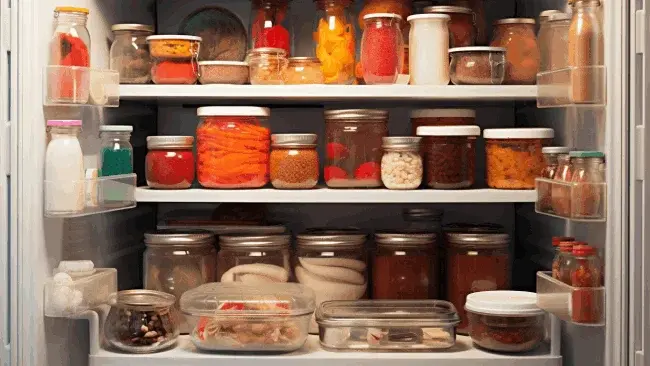
Adding this extra layer of protection creates a barrier preventing potential pollutants from entering your food and compromising its safety.
This hygienic practice contributes to overall food safety in your kitchen. Ensure that all storage containers are tightly sealed to prevent unwanted items from accessing your stored food.
No 08: Hygienic Practices with Opened Cans
When dealing with opened cans, you should transfer their contents into suitable containers to prevent potential contamination and ensure the safety of your food.
This practice is essential in maintaining proper kitchen hygiene and preventing cross-contamination. It eliminates the risk of bacteria or other contaminants entering the can and spreading to other foods by transferring the contents of opened cans.
It’s also vital to use suitable containers that are clean, airtight, and labeled correctly to avoid confusion and mix-ups. Also, proper labeling helps identify the contents and expiration dates, ensuring you use the food before it spoils.
No 09: Preventing Contact with Non-Food Areas
Continue practicing proper hygiene in your kitchen storage zones by preventing contact with non-food areas and avoiding cross-contamination. Store your food away from areas prone to contamination, such as dishwashing zones and garbage bins.
This simple precautionary measure helps minimize the risk of airborne or surface-borne contaminants coming into contact with your stored food items. By keeping your food separate from non-food areas, you can ensure that it remains safe and free from potential sources of cross-contamination.
No 10: Thorough Cleaning Practices
You must implement thorough cleaning practices to maintain a hygienic environment in your kitchen storage zones and prevent cross-contamination.
Regularly cleaning and sanitizing storage zones, such as shelves, bins, and containers, is crucial to eliminate potential sources of contamination.
Routine cleaning prevents harmful bacteria from spreading between surfaces and reduces the risk of foodborne illnesses. Use appropriate cleaning products and follow the manufacturer’s instructions for effective sanitation.
Pay special attention to high-touch areas and areas prone to spills or food debris buildup. Also, regularly inspect storage zones for any signs of damage or wear and replace damaged or worn-out equipment to maintain a clean and safe environment.
FAQ’s: Avoid Cross Contamination in Kitchen Storage Zones
How can I store my kitchen utensils hygienically?
You should practice cleaning your kitchen utensils regularly after using them to keep them clean and hygienic.
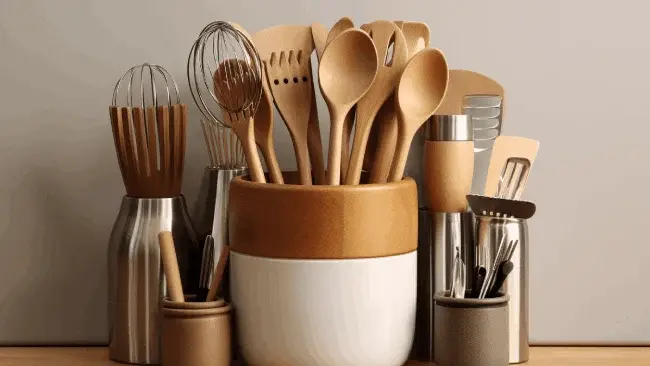
Begin by washing them with warm water and soap to remove food residue. Next, rinse them thoroughly with hot water, which will disinfect them and prevent the spread of bacteria. You can also soak your utensils in a mixture of equal parts water and vinegar to remove tough stains and any bacteria that may be present.
It is also recommended to clean your utensils in the dishwasher at the highest or lowest temperature setting (60°C/135°F or 4°C/41°F) to ensure maximum hygiene.
How can kitchen storage cross-contaminate?
Kitchen storage can lead to cross-contamination when raw and ready-to-eat foods are stored nearby without adequate separation. Placing ready-to-eat foods above raw meats in the refrigerator creates the risk of liquid drips transferring bacteria from the raw meat to other items.
Also, using the same cutting board or knife for raw and ready-to-eat foods without proper cleaning increases the likelihood of cross-contamination. Storing utensils and equipment near the hand wash basin can also transfer contaminants to hands during food preparation.
Conclusion
If you adhere to proper hygienic practices and are mindful of cross-contamination in kitchen storage zones, you can ensure the quality and freshness of your food.
Raw meats must be separated from other food items, storage areas must be regularly cleaned and sanitized, and ingredients must be stored correctly. These practices will protect your kitchen from pathogens and keep it healthy.
Don’t forget that a little extra effort goes a long way in preserving the quality of your food and protecting your loved ones from potential illnesses.
So, keep hygienic practices to avoid cross-contamination in storage zones in your kitchen.


